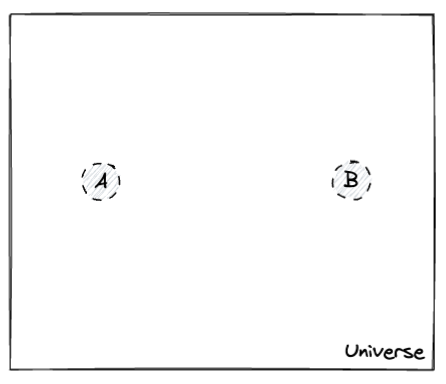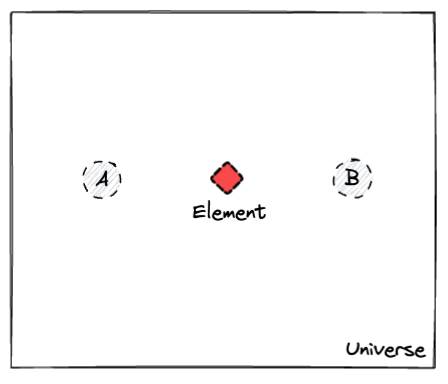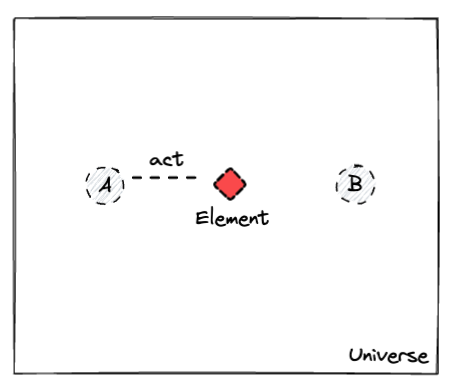About time and alphabets
Table of Contents
- Table of Contents
- Introduction
- Conception of time
- Determinism at work
- Language to Noise
- Conclusion
- References
Introduction
In 1967, Pamela Huby said this about Aristotle in “The First Discovery of the Freewill Problem.”
…he seems to be on the verge of saying that we cannot use the terms ‘voluntary’ and ‘involuntary’ literally of parts of the soul and to be treating ‘voluntary’ as meaning by definition, ‘that which originates from a man’s soul’, so that any application below the whole-soul level is ruled out. Whatever part of the soul it is that originates the action, the action remains voluntary.
Even today, there is no clear definition of what’s “voluntary” and what’s not; are protons “voluntary” or not? but a consensus has been made in all types of societies to be as arranged as possible. Physically speaking, it is well-discussed and studied, and I won’t go there in depth here (also, I’m not an expert in the subject).
However, there’s a specific link between motor behavior and the activation of neurons in the cerebral cortex. However, something fundamental happened between 1967 and now: humans seem to learn that they don’t have free will (and of course, this is not a surprise!).
We have now (which, by Internet standards, is pretty old) a model trying to explain almost everything.
Conception of time
The conception of time is intrinsically coherent with the idea of life beyond words: no other species on earth can and will be able to understand our symbols (symbolic references to knowledge), and because of this, speak and text as content will continuously be compacted to this particular society on earth.
I wonder if even our species will understand the words and conjectures of tokens only six hundred years from now.
In contrast, life places a question: Are we, as humans, free?
The first response could be: choosing.
Nevertheless, according to Bergmann Frithjof, freedom is not the act of choosing but of being able to understand essential actions, because you believe in them.
On Bergmann’s Theory of Freedom by Stephen Ball, the coined term of being free goes as
An act is free if the agent identifies with the elements from which it flows; it is coerced if the agent disassociates himself from the element which guarantees or prompts action
Comparing actions and being free nowadays, it’s starting to feel more towards what Bergmann claimed in his book On Being Free.
Individuals have the power to choose, but not because of that; they are free.
Based on his idea and view about freedom, Bergmann created a framework to do meaningful work called “New Work,” where agents in the system work towards self-confidence, trust, and independence using and manipulating technology to generate and produce the outcomes we want.
Even so, the world is moving towards a self-centered view of work, and this idea will definitely fit in in the next few years if it’s not happening now. So, while trying to keep ideas of independent production of goods always in place, it’s commonplace for those to fight against each other to decide what to choose from.
A decision example
If we can talk precisely about actions performed by an individual in a set amount of time, we can predict a potentially severe set of future movements. However, movements happen (as in any complex system), making it complex to understand as time increases.

In a theoretical exploration of decision-making within a constrained system, consider a simplified model consisting of two agents. These agents are capable of only two distinct actions upon encountering a scenario: act or ignore. Initially, the environment these agents inhabit is devoid of stimuli – a blank slate offering no information for interaction.
A single symbolic element is introduced into this environment as the system evolves. The agents, upon encountering this element, exercise their decision-making capabilities. Their actions, or lack thereof, are meticulously logged, creating a historical record of interactions. For instance, the log might reflect actions such as:
Agent A decides on Element
Agent A <act> on Element
Agent B decides on Element
Agent B <ignore> Element

This log illustrates the binary decision-making process in its simplest form. With each new iteration or epoch of the simulation, the agents are presented with the same singular element, leading to a variety of potential scenarios:
Agent B may <act> towards Element
Agent B may <ignore> Element

This process repeats, exhaustively exploring all possible actions in relation to the Element.
In this microcosm, the act of choosing – to engage or to disregard – is fundamentally binary. Given that each choice is independent (the discussion of interdependent actions is reserved for a more complex model), the total number of possible actions for each agent against an element is represented as:
Actions = (C^N)
Where:
C = number of actions (2 in this case: act or ignore)
N = number of elements (1 initially)
This formula allows for calculating potential outcomes based on agent decisions.
In this model, agents are limited to decisions regarding the presence of an Element within their universe. The scope of their choices is confined to the singular element available in their ecosystem. They cannot choose between multiple elements (e.g., Element_1 or Element_2) as the system’s design does not support such complexity.
However, the illusion of choice expands as the system evolves and more elements are introduced.
The decision-making landscape becomes increasingly complex, offering a broader array of potential interactions.
This expansion illustrates a fundamental principle: the complexity of choice within a system is directly proportional to the number and nature of stimuli in that system.
However, the decision system based on and used by humans is broken, and the illusion of choosing between one or the other Element is pointed towards the incapability of the human mind to recognize from a massive set of potential decisions which one we are choosing.
Determinism at work
Determinism works both in the mechanical and in the quantum world. Particles don’t go around asking people names or being more of what they are. Knowledge is aligned with the beginning of its philosophical movement. Those who know will understand, and it’s about how many symbols you can recognize.
Slack of skin makes you perish without blood, sand, and salt.
Now, knowing an end, you can (and I believe it will) be shaped by a deprecated system for every word written. A system that is no longer able to maintain its empire, with weapons no other than words, that uses the luck of arrangement to be able to communicate complexity.
A symbolic lettering system (alphabet) cannot communicate pure information having infinite permutation of symbols, and on top of that, rules of which later the same system can produce pure noise. **We need to create a symbolic system that allows us to not lie on the count, not even the content or
As matter alphabets allow us to produce noise, we will be in a complex non-redundant situation. Despite this, humans need a more robust communication system with historical characteristics.
Will new empires reign without words?.
Still, grammatical rules across intersectional domains will be the kings & queens of the physical world.
A mathematical language that put us closer to a God. A logical one.
Language to Noise
When humans decide, they tend to speak (or think the same way we speak), although this communication of ideas is always done so that the environment or even the message’s sender makes the signal noisy. In addition, languages provide humans with a means to transmit, transform, and evolve ideas from simple energy spikes into complex and robust mechanisms that fundamentally change the world as we know it. Languages also enable the creation of concepts that do not exist in the real world and comparing hypothetical scenarios.
However, current linguistic systems present a double-edged sword to humans. The flexibility of language often leads to uncontrolled noise. The following hypothetical system is proposed after discussing free will and the freedom of choice. This system restricts humans from using a fixed set of symbols and rules, preventing adding more elements.
Computers are powerful because they facilitate abstractions, the foundation upon which empires are built. However, speaking amidst noise will always be an unavoidable challenge.
In the following hypothetical construct, let’s introduce a symbolic system with a binary alphabet consisting of two symbols, <1> and <0>, representing true and false logic states, respectively.
This system is further defined by a set of constraints we call <grammatical rules>, shaping how symbols are combined and interpreted.
Bypassing these rules will be penalized by the system, causing the word not to be recognized.
Symbolic System Constraints:
- Fixed Word Size: Words, or sequences of symbols, are limited to a maximum length of 2.
- Permutation Restrictions: Symbolic permutations are not allowed at the (letter + 2^n) level, implying a structured and predictable pattern of symbol arrangement.
- Combination Prohibition: Words cannot be combined, ensuring each word stands alone in its meaning and interpretation.
Representation
Using these rules defined above, we construct a table of truth for “words” within our system and their associated meanings:
| Words | Explanation |
|---|---|
| 01 | A false event with a true result |
| 00 | A false event with a false result |
| 10 | A true event with a false result |
| 11 | A true event with a true result |
| EOS | End of symbols |
Each combination of <1> and <0> is assigned a specific meaning, creating a precise, unambiguous mapping between the symbolic representation and its interpretation in the domain of discussion.
Flow
In this commented symbolic system with the format “state > result,” each two-symbol word comprises a “state” (the first symbol) and a “result” (the second symbol).
This format provides a structured method for interpreting the symbols:
- State (First Symbol): Represents the initial condition, either
<1>(true) or<0>(false). - Result (Second Symbol): Indicates the outcome, also
<1>(true) or<0>(false).
The words “01”, “00”, “10”, and “11” thus correspond to different scenarios:
- 01: False state, true result.
- 00: False state, false result.
- 10: True state, false result.
- 11: True state, true result.
This system workflow allows for precise, logical interpretation of the coordination of actions.
Limitations
While precise within its domain, this system faces limitations when interfacing with other symbolic systems like Castellano or American English, for example.
The inability to map these words to systems that do not adhere to the same rules or without knowledge of the specific symbolic rules of the receptor system highlights a critical challenge: the potential for misinterpretation or “noise” in communication across different symbolic frameworks.
The constraint of not allowing permutations at certain levels and the prohibition of combining words serve to reduce ambiguity and noise, enhancing the clarity and specificity of communication within the system.
However, these same constraints limit the system’s flexibility and adaptability when interfacing with external systems.
Conclusion
In conclusion, in my view, society needs to create a symbolic reference system with a set number of symbols and a defined rules engine that allows us to communicate by avoiding noise as much as possible.
The system effectively reduces noise by attaching domain-specific meanings to symbol combinations and imposing grammatical constraints. It allows agents to communicate bi-directional without wasting too much energy in the speaking format.
However, this comes at the cost of reduced versatility and potential challenges in cross-system communication. The balance between precision and adaptability is a crucial consideration in designing any symbolic system, particularly in the context of knowledge creation and transfer.
References
- Philosophical Investigations - Wiley Online Library
- Gödel, Escher, Bach - Wikipedia
- The Beginning of Infinity - Wikipedia
- Pareto Front - ScienceDirect
- LessWrong: Slack and Constraints
- LessWrong: Theories of Pain and Pleasure
- The Dunning-Kruger Effect and Autocorrelation - Economics from the Top Down
- Skill, Luck, and the Pareto Principle - Dan Luu
- On Being Free - Archive.org
- Free Will - Internet Encyclopedia of Philosophy
- The Problem of Free Will - JSTOR
- Thinking in Systems: A primer